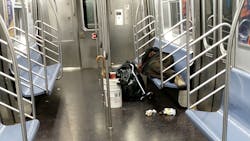OIG MTA report calls New York transit agency’s homeless outreach efforts sincere but deficient
The Office of the Inspector General (OIG) Metropolitan Transportation Authority (MTA) published its report on the MTA’s homeless outreach efforts, which the report determined to be deficient and the MTA Inspector General Carolyn Pokorny called them outside the agency’s “expertise and purview.”
The OIG report also labeled the challenge of homelessness on the subway “an urgent and evolving situation” with the arrival and spread of the COVID-19 pandemic.
“The disturbing conditions on trains and platforms – scores of homeless individuals, without protective facemasks, splayed out in subway cars along with all their belongings – were widely reported by the media and NYC Transit employees,” reads the introduction of the report. “These unsanitary conditions endangered the safety of NYC Transit employees and other essential workers traveling to and from their critically important jobs (as well as the homeless individuals) by reducing their ability to practice safe social distancing and raising their risk of infection.”
The report also notes that the conditions detailed above could prolong the financial strain of the pandemic on the MTA and the region because “any reluctance by riders to return to the subway system will hinder the region’s return to economic and social well-being.”
“Sheltering in the transit system has always been tragic, but now it is dangerous – for the homeless individuals, MTA employees, essential workers and other members of our ridership – especially during a pandemic,” said MTA Inspector General Carolyn Pokorny.
In June 2019, several New York City departments, which included the MTA New York City Transit and New York Police Department, said they would work together on the Subway Diversion Project, which was designed to be a pilot initiative aimed at moving unsheltered individuals living in the subway to supportive programs instead of the criminal justice system. The MTA and the New York State Office of Temporary and Disability Assistance (OTDA) formed a task force and in October 2019 unveiled a plan to help the problem.
Among the plan elements were enhanced outreach and expanded oversight of New York City outreach efforts; an expanded MTA police force; MTA Rules of Conduct education efforts; increased interagency cooperation to support homeless outreach and oversight by OIG.
The OIG report determined the $5-million annual program was unsuccessful based on goals, metrics and data that were lacking “despite MTA’s sincere efforts to connect individuals sheltering in transit facilities to the services they need.”
The report finds that most of what is needed to move homeless people out of the transit system and into more appropriate settings is beyond the MTA’s control, expertise and mission. The report says the agency should work in cooperation with the city government’s experienced social services and law enforcement professionals to reduce the impacts of homelessness on its operation.
The OIG report also found flaws in the MTA’s contracted services, including the more than $2-million annual contract with Bowery Residents’ Committee (BRC) and $3-million annual agreement with the city. Through its review, OIG found that the MTA needs to focus on evaluating its programs and making changes to yield greater results.
OIG also determined significant deficiencies existed in the MTA’s collection, reporting and sharing of data and performance metrics. OIG provides the example that data would focus on BRC staff productivity rather than the reduction of unsheltered individuals from MTA facilities. OIG says MTA lacks the ability to track crucial metrics such as how many homeless individuals shelter in the subway system and how many individuals have been successfully diverted from MTA facilities despite “years of working” and spending at least $2.6 million on MTA police overtime between August 2019 – February 2020.
“From a fiscal perspective, I simply cannot condone the MTA continuing to spend millions of taxpayer dollars addressing complex social ills that are outside its expertise and purview—especially when it just isn’t working. This is particularly true now that the MTA is in unprecedented, dire financial straits and grappling with a pandemic. This is no time to spend scarce transit resources on anything except solutions,” said MTA Inspector General Pokorny.
To address the areas of weakness noted in the OIG report, the MTA should reevaluate and redesign its efforts to address this complex challenge, in cooperation with its social service and law enforcement partners in New York City government. To do so, OIG issued 9 recommendations, specifically that MTA focus on what it can control, improve the information it relies on for managerial decision-making and institute more robust oversight methods to ensure that outreach and enforcement efforts are aligned to reflect its priorities.
MTA agreed with the findings of the OIG report and is taking steps to improve its data collection and contractor oversight, evaluate the cost-effectiveness of its efforts and work closely with the city.
About the Author

Mischa Wanek-Libman
Group Editorial Director
Mischa Wanek-Libman is director of communications with Transdev North America. She has more than 20 years of experience working in the transportation industry covering construction projects, engineering challenges, transit and rail operations and best practices.
Wanek-Libman has held top editorial positions at freight rail and public transportation business-to-business publications including as editor-in-chief and editorial director of Mass Transit from 2018-2024. She has been recognized for editorial excellence through her individual work, as well as for collaborative content.
She is an active member of the American Public Transportation Association's Marketing and Communications Committee and served 14 years as a Board Observer on the National Railroad Construction and Maintenance Association (NRC) Board of Directors.
She is a graduate of Drake University in Des Moines, Iowa, where she earned a Bachelor of Arts degree in Journalism and Mass Communication.
